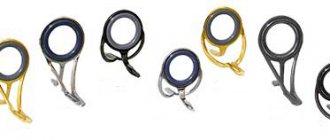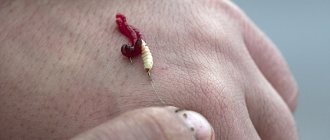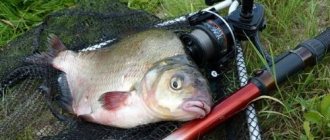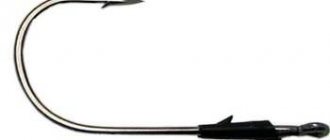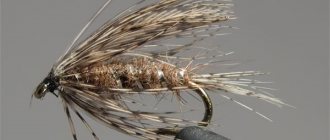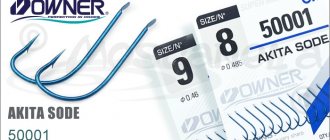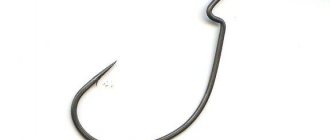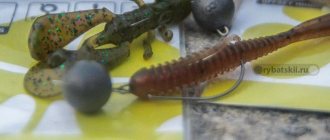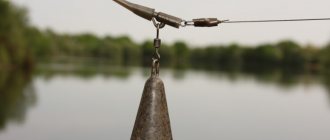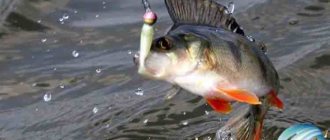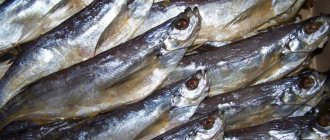Types of sharpening
Owner fishing hooks have two types of sharpening. The first type is called Cutting point. This sharpening option was developed by the company specifically for anglers who prefer to catch predatory fish. Products with Cutting point sharpening are characterized by a triangular cutting edge and allow you to reliably cut through fish whose mouth consists of hard tissue. These hooks are indispensable when fishing for such types of fish as:
Models with Supper needle point sharpening have a classic needle-shaped tip. Hooks sharpened with a Supper needle point cause virtually no damage when penetrating soft tissue, therefore, as a rule, they are used for catching white fish. Information about the type of sharpening is indicated on the packaging, thanks to which the angler can choose a model that will be optimally suited for fishing a certain type of fish.
Types of hook sharpening Owner
To date, only two types of sharpening are known that can be used on Ovner brand hooks:
- Cutting point (CUTTINGPOINT). Since the company is Japanese, this type of sharpening is based on the principle of giving sharpness to a samurai sword. This feature is unique to the Ovner company. Hooks sharpened to the principle of a sword have the properties of an instant cut, which can prevent you from catching fish with soft tissues in the perioral cavity. And for fish with hard near-mouth cavities, this type of hook is simply ideal.
- Needle point precision (SUPPER NEEDLE POINT). This type of sharpening, as the name suggests, hits the target without causing injury to the skin of the fish’s mouth and will only contribute to a good catch.
Design features
On the packaging of Owner hooks there are various symbols that determine the design features of the model. Having learned the meaning of these inscriptions, the angler can quickly get an idea of the design of a particular hook. The following designations may be applied to the packaging:
- Press Bard - indicates the presence of a beard on the product, made using an innovative pressing method. Many anglers have noticed that such a beard holds the fish more reliably during the fishing process and practically eliminates slips.
- Small Bard - indicates that the product is equipped with a beard that is reduced in size. These types of hooks are often used by catch-and-release anglers because they are less likely to injure the fish. In addition, models with a small beard are better suited for fishing on delicate baits, such as bloodworms.
- The abbreviation STB is found on the packaging of treble hooks and indicates that all elements of the treble are perfectly balanced and of the same size.
- Oval Ringed - indicates the presence of a fastening element in the form of a ring having an oval shape. Such products are widely used in fly fishing, since the narrowed ring allows them to be used for tying flies on metal tubes.
- Forged - this abbreviation means that the hook has a laterally flattened, forged hook, which significantly increases the strength of the product.
- Ringed - indicates that the design of the hook contains a classic fastening element in the form of a round ring.
The absence of the inscriptions Ringed or Oval Ringed means that a spatula is used as a fastening element. Hooks with a spatula have minimal weight and are more often used for fishing with float tackle.
Feeder hooks from Kamasan
Another Japanese manufacturer of quality fishing hooks is Kamasan . For feeders, Kamasan hooks may be even more popular than Owner. Recommendations from well-known feeder experts could not but affect the choice of models from Kamasan. There are only a few popular series, but they more than cover all the needs for feeder fishing.
Kamasan B525 series
Reliable, hooky model with a ring. The manufacturer positions them as float rods, but as practice shows, they are also excellent for bottom fishing with a feeder. They are also universal in relation to bait.
Kamasan B532 series
Red hooks with a spatula. Made from thin wire. Excellent for worms and bloodworms. They are quite suitable for feeder fishing. You can catch white fish and carp.
Kamasan B651 series
Reliable for feeder fishing. They have a round shape, a small fore-end and a blade. Can be used for various attachments.
Kamasan B980 series
Some of my favorite hooks. Numbers 4-6 can be used on carp. Smaller size for crucian and white fish. The considerable diameter of the wire gives increased strength. Suitable for attaching a bunch of worms and various grains. I recommend.
Kamasan B983 series
Also a very popular series. Curved tip and short fore-end. Universal for different attachments, they fit perfectly into equipment. I use numbers from 4 to 16.
Color solutions
provides a large selection of hook colors, which is very important, since the color of a fishing hook can affect the number of bites. The Owner assortment includes products in ten color variations:
- black - most in demand when fishing for carp, when boilies or pellets are used as bait;
- golden - best suited for fishing with corn kernels;
- bronze and blue - show the best results in combination with baits such as crawler and earthworm;
- lilac and red are ideal colors for fishing with bloodworms or dung worms;
- green - works great in heavily overgrown reservoirs, as well as when fishing for caddisflies, thread grass and green-colored maggots.
The fisherman should not neglect the choice of hook color, since this factor can influence not only the quantity, but also the quality of bites.
The color of the hook must be selected so that it is as close as possible to the color of the bait used.
Owner hook classification
There are many varieties of hooks in the line. Having learned to understand their classification, the fisherman can easily select a model that matches a certain type of gear and a specific type of fish.
Models for fishing with feeder and float tackle
Fans of feeder and float fishing will find in the Owner product range many models of single hooks for catching both small and trophy fish. The following series are well suited for the feeder fishing method:
- 50001 - has a blue color and is available in sizes from No. 18 to No. 3 (according to the international classification). It is characterized by an elongated fore-end, which allows the use of worms and filamentous algae as bait. It is successfully used for fishing roach, crucian carp and bream.
- 50188 - this series is made of fairly thick wire, which makes it possible to use vegetable attachments such as mash or semolina dough. Series 50188 is available in sizes from No. 12 to No. 1, has a black color and is better suited for fishing for crucian carp and tench.
- 53100 is the most versatile series of feeder hooks, having a golden color and an elongated shank. The classic round bend allows you to use any type of bait in combination with these hooks.
- 50921 is a model with a straight bend, which is most often used when fishing for crucian carp and bream. Works better with animal baits such as worms and maggots. Available in sizes No. 10 to No. 16.
- 50152 is a very popular series among anglers, characterized by an inwardly curved fastening element in the form of a ring. The short shank and medium diameter of the wire from which the hook is made make it convenient to use hard types of plant baits.
Most floaters catch bream on Ovner hooks of the 50922 and 53117 series, which have proven themselves well in combination with bulk baits consisting of several bloodworms and maggots. For fishing for roach, silver bream and bleak, the 50282 and 50363 series are most often used, made of very thin wire and having minimal weight and size.
Feeder hooks from Owner
If we talk about good hooks, then the company Owner . Ovner company will also be mentioned first .
This manufacturer has become the de facto standard of sharpness and reliability. For about 50 years, the Japanese company Owner has been producing not only hooks, but also fasteners, swivels, lines, wobblers and other fishing accessories. Ovner even has his own patented sharpening method.
The range of products offered is simply huge: from the tiniest to super-reliable shark hooks. Only in our stores, not to mention markets, it is not always possible to choose from this entire assortment. But the most popular and beloved series by many are most often on sale in fishing stores in large cities, and even more so on various marketplaces.
As for the provinces, the choice here is very modest. It happens that it is not possible to find not only the desired model of feeder hooks, but even models from Owner in general.
The problem of counterfeit products is acute for Ovner. Popularity, considerable price, and the desire of the fisherman to try the “sharpest and most reliable” hook from a well-known brand – these are the incentives for scammers. And as a result, we often hear reviews from disappointed fishermen about the poor quality of products from this brand.
Trusted fishing stores, ordering online from popular foreign online stores - this is what can help fishermen make the right purchase. Well, or simply switch to other brands that are less counterfeited.
Which models from Owner choose for the feeder
We list the running series in ascending order of series number:
Owner series 50001
Thin hooks with a spatula, blue. Ovner positions them as suitable for fishing with “tinka” (greens). They are often used for feeders. The attachment can be a dung worm, a crawler, or grains. In short, everything that matches the number and the fish. The thin wire on this series makes it possible to use them for catching not very large fish.
Owner series 50152
The same model already has a ring, and the ring is bent inward. They have a short forearm. They are more suitable for feeder fishing with maggot, pearl barley, corn, hominy and other similar baits.
Owner series 50188
Excellent fishing hooks with a ring. Used by many fishermen both on a float and for bottom tackle. You can attach various plant and animal baits to them.
Owner series 50282, 50286
Very popular for feeders, similar two series of hooks with a spatula. No. 14 is one of my most popular hooks. Although I don’t like to be too detail-oriented with numbers (may our sporting gurus forgive me), for bloodworms there is nothing better for me. Although, again, you can use the nozzle at your discretion. The hooks of this series are reliable and hold the fish well when playing.
Owner series 50340
Model with a spatula. Available in three types of coatings: Black Chrome, Gold or Oxidize Gold. For feeder fishing, numbers 10-12 are mainly used. Almost any attachment that will correspond to the hook number.
Owner series 50344
Hooks are very popular for feeder. The tip is bent and specially processed using the “forged prying” method. Identical series 50342, 50343, 50345 differ in coating. Popular No. 12-18. The bait can be anything. Excellent, durable hooks, they can be safely recommended for use.
Owner series 50354; 50363
The manufacturer recommends them for winter fishing. But our fishermen successfully use them for bottom fishing on a feeder. Good hooks with a spatula and a round bend.
Owner series 50457
As you can see from the form, this is a model for using the worm. She has proven herself to be excellent.
Owner series 50922
Popular series with a ring. They have a slightly beveled rounded bend and a ring. Nozzle – almost any.
Owner series 50921, No. 10-14
Another great series with a ring. They are better suited when using a worm, but you can also fish with other baits.
Owner series 53100
Excellent universal hooks with an extended shank, round bend and blade. My running number for feeder is No. 12. The nozzle can be very different.
Owner series 53157
Brownish, unusual shape. The short hook and beveled bend give this hook the ability to hold a variety of baits. Popular #10-12. Worm, maggot, corn, pearl barley - in short, everything that our fish might like.
Here is a rather large selection of feeder hooks from Owner. It may seem like an advertisement, but what can you do, you can’t hide popularity. Although, in recent years it has become increasingly difficult to find a real Ovner, and other manufacturers offer models that are not at all worse. So let’s turn our fishing gaze to the remaining three manufacturers.
The main differences between a fake and an original
In the fishing market, as in any other industry, there are often fakes that do not at all correspond to the quality of the original product. Counterfeit Owner hooks can be distinguished from the original by several characteristics:
- For a counterfeit product, the size indicated on the package is very different from the actual hook number. Such a discrepancy is easily determined by visual inspection of the product.
- In the series of original products, odd numbers of hook sizes are extremely rare. Counterfeits have odd numbers quite often.
- The information on the number and color of hooks indicated on the original packaging always coincides with the actual ones.
- Original products should not differ from each other in size and shape.
- The price for high-quality hooks cannot be less than 100 rubles per package.
To maintain the constant sharpness of the hooks, the angler should purchase an Owner sharpener, with which you can quickly sharpen the hook right on the shore of the reservoir. This sharpener is a small keychain that can easily fit in the pocket of a backpack or jacket. It is important to remember that hooks of at least size No. 12 can be sharpened, since smaller products have a thin protective layer, the grinding of which is unacceptable.
In the Owner line, every angler can find a hook that is ideal for his favorite type of fishing. The correct selection of the color, shape and size of the hook will ensure a stable bite and reliable hooking of fish.
Overhead hooks for fishing: description, classification, reviews
Has it ever happened that you hooked the fish of your dreams, your heart quickens its rhythm, almost on a subconscious level you apply all your strength, experience and dexterity to pull this beauty ashore. You already see it! And suddenly she, waving her tail, swims away from you. Having taken out your tackle, you ascertain the fact that the hook is straightened. Well, all that remains is to shrug your shoulders and come up with a couple of excuses to reassure yourself. But you can go another way. Which one? Buy quality gear. In this case, Japanese owner hooks.
In this article we will look at the classification and description of fishing hooks. But first, a little about the company where this quality product is made.
Back in 1968, the now well-known company Owner . Soon, due to the wide demand for the product, there was a need to expand production, so in 1975, Owner moved to Tomita-town. Currently, the company produces its products not only in Japan, but also in the Philippines and China. I would like to note that the quality of the products was not affected.
By using the latest scientific technologies and collaborating with institutes that study the habits and anatomy of fish, the company has always managed to keep up with the times. Over the 49 years of its existence, the Owner company has been able to develop a simply huge variety of fishing hooks. In the catalog you can find hooks for any fish from giant sharks to roaches weighing several tens of grams.
Description of fishing hooks owner
Owner hooks are made of steel wire . Thanks to this, they have high strength despite their small size. For different models of hooks, different thicknesses of wire are used, which makes it almost invisible to the fish. The varied color range of owner hooks also helps with this.
Owner fishing hooks have different shapes, from Z-shaped to the usual fishing hooks. Forend of various lengths and shapes. The head can be in the form of a blade or an ear and also have different inclinations. The head and forehead of the owner hook are curved differently for different fish species. The beard also has different inclinations in different cases; in some types of hooks it is bent inwards, and in others to the side, for better hooking of fish.
Owner hooks come in single, double and treble types. Each of them is designed for a specific type of fishing, as well as for different types of fish. In turn, these subspecies are divided into separate series, from which you can choose the most suitable options.
Manufacturing technology and materials of OWNER hooks
The entire range of hooks is made only from the highest quality steel, the safety factor is the highest. This company has a very good range of hooks. The company has its own slogan:
Every fish and fishing must have its own hook!
The well-known company OWNER is a constant partner of the research laboratory, which is located in the building of the institute. There they not only know everything about fish, but also study further: behavioral characteristics, structure, etc.
All types of fish have their own, unique differences: the method of swallowing food, the shape of the mouth, the method of grasping the bait.
Based on these studies, experts were able to create many varieties of hooks. They were developed for: sports, amateur, and even for a specific type of fishing. But many fishermen still think about it before buying, and cannot always make the right choice.
It's not difficult, you just need to read all the information that is detailed on the packaging. It contains the necessary symbols and graphic symbols. They display the characteristics of the hooks. Now we will dwell on this in more detail and find out what these designations may be and how they will be deciphered.
Features of tees
In order to solve this problem, you can replace the supplied hooks with those from owner . They are made of high-quality steel, and the tees from this manufacturer are consistently sharp, which will help increase the statistics of successful hooks. Defective options are very rare; there are no problems with overheating, which could cause the hook to lose its strength altogether.
An interesting feature is the unique property of the metal. The flexibility of the hook is not always detrimental. Manufacturers have managed to achieve an optimal balance, which allows, on the one hand, to guarantee a successful hookup, and on the other hand, if you have a good cord, unbend it in case of a snag, and not lose the expensive bait. Not every fishing tackle manufacturer can boast of this feature.
The only difficulty that arises is to correctly calculate the hook series for a certain area so that it is suitable for the maximum weight of the possible fish. Then you can be sure that your catch will stay with you and not run away, straightening the hook on the bait.
How to distinguish an original from a fake
This point is important so as not to be disappointed in a rather expensive purchase. There are several rules by which you can distinguish cheap, and, accordingly, low-quality copies, from sharp and practical originals.
- Visually inspect the pack. Above the barcode located on the back of the package, you can see the model name and size, which are already indicated on the front of the package. On a fake they often do not match.
- Owner is an international company, so there may be hooks not made in Japan. However, when making a fake, they always write Made in Japan.
- If you buy an odd-numbered option, be especially careful. They are produced in limited editions, so they are quite rare on sale. If possible, and this is not critical to the result, it is recommended to purchase even sizes, and remember that the numbering differs from what is usual in post-Soviet countries.
- Pay attention to the cost, and do not try to buy hooks as cheaply as possible. Such savings are unlikely to be beneficial.
- Check the official catalogs provided by the fishing hook manufacturer. They always indicate all the details, including series, size and even color. Counterfeits often pay significantly less attention to detail, which makes it possible to detect the counterfeit.
- Compare hooks from the same package. The original ones will all be similar, as if they were a carbon copy, while copies are often different, and the workmanship is noticeably poor, and there may be burrs on the tip.
Characteristics Analysis
In addition to the number, thickness and shape, there are additional factors to consider. For attachment to the fishing line, the design may include a closed ring or blade. The first is convenient for knitting catch, but affects the increase in size. When choosing small sizes, it is recommended to choose a shape with a spatula - after tying a knot, the wire will visually immediately move to the fishing line, without intermediate elements in the form of a ring.
Tips for a fisherman: How to make a feeder tackle for bream - Features of choice
When choosing, pay attention to the following qualities:
Some manufacturers offer exclusive hooks for this type of fish, supposedly different from the standard ones in shape. In practice, small changes in configuration will not affect the likelihood of a successful catch, and in some cases may negatively affect the bite. It is recommended to choose classic and time-tested models.
The video material reveals the secrets of choosing fishing equipment as fully as possible:
External difference:
Advantages and disadvantages noted in user reviews
In order to make a final conclusion regarding the manufacturer of owner fishing hooks, you should familiarize yourself with the opinions of fishermen who have already been using them for some time. Among the main advantages , most often found in reviews, are the following:
- The sharpness of the sting. There are no complaints here in every episode. This, in turn, provides excellent hooks and increases the overall probability of catching.
- High quality steel alloy. The metal does not break due to external influences, and is able to cope with high loads.
- Flexibility. Despite the fact that this can often be considered a disadvantage, in the case of this manufacturer the balance is chosen correctly. The sting can almost always be released from the hook by straightening the metal, but at the same time it does not behave badly when hooking or landing fish.
- Wide choose. A large number of series and sizes allow any fisherman to choose exactly what is needed in his situation. And thanks to this, their prevalence increases, which makes it possible to buy them in almost any store.
However, in addition to the positive aspects, there are also disadvantages , which, however, cannot be called critical. The first is the slipperiness of the metal due to perfect polishing. As a result, using it with fishing line is problematic; the use of braided cord is recommended.
The second one can hardly be called a disadvantage, but many people notice it. This is a high cost compared to competitors' offerings. However, you must agree that sometimes it is better to overpay for confidence and quality.
As you can see from this, owner products are perfect for both beginning amateur fishermen and avid professionals participating in competitions. All that remains is to purchase it, plan your time and enjoy your catch.
Hook selection criteria
Bream is quite a favorite prey for every fisherman. The fish itself is quite large, and catching it is not so difficult. It is important to prepare all the gear and especially the hooks in advance. The following should be taken into account here:
- estimated fish size;
- bait;
- company manufacturer.
Estimated fish size
The size of the hook is directly affected by the size of the fish and its weight; the larger the fish, the larger the hook itself should be.
At the same time, it is necessary to take into account that when buying large sizes, you should not count on the fact that even a small fish will fall on it; most likely, it will simply fall off or not catch at all. Likewise, with a small hook, you are unlikely to catch a large bream; the fish can simply bend it and swim away.
For small or medium bream you need fishing tackle from 8 to 14 numbers . And for fish weighing more than 3 kg, numbers 4 and 6 will be needed .
With large hooks, the fish are very careful, so there are much fewer bites with them. If you expect to take at least some catch with you, then change the large sizes to small ones.
Bait
If you have good quality gear, then the type of bait will further influence the number of fish you catch. The hook can remain unchanged, but the bait can be changed if necessary.
Main types of baits:
Company manufacturer
Of course, it is best to choose hooks from trusted manufacturers. This way you won’t be left without a catch if a fish suddenly gets caught and the product breaks. With careful treatment and quality care, they can last you for several fishing seasons.
Reliable manufacturers include:
- Owner.
- Gamacatsu.
- Cobra
- You can simplify the installation of the worm by using a hook with an extended shank.
- For bloodworms, the option with a thin wire thickness is more suitable. However, the fragility of the product is determined by the difficulties when catching fish in the autumn or spring.
- If the bait is of animal origin and large, option No. 15-8 is suitable. Thin ones will not be able to withstand the applied load, as a result of which the metal rod breaks off.
A large number of different companies produce this type of equipment. But, which hooks are best for a bream feeder, experienced fishermen believe that you should pay attention to the products of the following manufacturers:
As a rule, the choice is made taking into account the allocated budget and specific fishing conditions.
If we consider popular models, it is worth highlighting the most popular hooks for bream on the feeder:
For beginners, universal options that perform well in various conditions are ideal. After gaining the required experience, you can choose hooks suitable for specific fishing conditions.
Everything is simple here: the sharper the sting, the better. So when feeder fishing, especially if the bottom is rocky or even just hard, do not forget to periodically check the hook. Run your fingernail along the sting: if it becomes dull, change the hook without regret. Otherwise, the reliability of the hook may be insufficient.
Everything is simple here: the sharper the sting, the better. So when feeder fishing, especially if the bottom is rocky or even just hard, do not forget to periodically check the hook. Run your fingernail along the sting: if it becomes dull, change the hook without regret. Otherwise, the reliability of the hook may be insufficient.
Tips for a fisherman: How to cook peas for bream fishing - Tips for a beginner
There is a dilemma here, especially for experienced feeders - everyone has their own tactics. Some people prefer to take a smaller hook, since it is easier to disguise it with bait and, accordingly, there is a higher chance that a cautious bream will swallow the bait.
Others believe that a large number is more reliable, since it makes it more difficult for a large fish to escape when hooked. Plus, unnecessary little things won’t fall on a serious hook. So which option should you choose, larger or smaller?
We believe that the easiest way to focus is on the nozzle:
If you are baiting with a worm, use long or medium shank hooks in size #10-6.
If you fish corn, dough (see how to prepare it for bream), mastyrka or pearl barley, give preference to the middle numbers - No. 14-8.
If you are baiting maggots, and especially several, take hooks of size No. 14-10.
If you settled on bloodworms, give preference to No. 16-14.
If fishing takes place on a lake with standing water, then a rod up to 3 meters long is used. A spinning rod consists of 3-4 parts. The tops should be of different hardness.
Owner hooks are a mark of quality among fishing tackles
OWNER is a well-known manufacturer of fishing hooks that have a high strength coefficient. Hooks are made from high quality steel and have a wide range of products. The popularity of this company's products is determined by its individual approach - a special type of fishing hook is designed for each type of fishing. In addition, OWNER has established close partnerships with global research institutes that study fish in detail. The information obtained plays a key role in creating a particular type of hook, since there are behavioral (method of swallowing food) and anatomical differences (structure of the oral cavity) between different types of fish. That is why OWNER has created hooks that are suitable for a specific fishing method and for a specific type of fish.
Hook series and codes OWNER
Like any other product, OWNER hooks have their own series and names. The most popular series are: • S-59; • Pin Hook; • K-beak. In addition to an easy-to-remember name, there are digital articles that encrypt basic information about the name and color scheme. This article displays coverage information and other useful data. For example, if we consider the well-known Pin Hook series, which has two codes - 50922 and 53135, then we can talk about black chrome plating, and the second code talks about gold plating. But the most memorable element is the number that indicates the nominal size.
Specialization series of hooks Owner
As already mentioned, all hooks produced by Owner have a certain specialization. To simplify their classification, all models can be divided into four main groups depending on the features of their design. Each of these groups will be discussed in more detail below.
Single hooks with ring
This group unites the most common and standard models of hooks, in the lower part of the structure there is a fastening element in the form of a ring.
The main models belonging to this type are discussed below:
- K-Beak 50108 or 51437 are hooks with a classic gold or black chrome finish and a thicker diameter. This increases their strength, which is why such models are used for catching large and strong prey, primarily carp.
- Amano Tenkara 50152 are bronze hooks with a forged hook, usually used when installing the heaviest jigs with an eye.
- Iseama With Eye 50188 are universal models with a black chrome finish, often used for catching herbivores, omnivores or semi-carnivores.
- Chinu With Eye 50355 is similar to the previous version, but with a groove turned to the side. They are universal devices for any float or bottom gear.
- Kuwahara Tenkara – S 50457 – these are bronze hooks with a forged hook; the design feature is an elongated fore-end.
- Kuwahara Tenkara – D 5048 is an analogue of the previous version with a modified location of the fastening ring, which is bent inward.
- Honryu Tenkara 50656 – bronze hooks designed for mounting jigs and flies.
- Penny Hook 50921 - universal hooks with black chrome plated, usually used for catching all types of predators.
- Pin Hook 50922 or 53135 is an analogue of the previous version with a black chrome or gold finish, but is mainly used for catching herbivorous prey.
- Carp Down 51455 are highly specialized black chrome hooks designed for carp fishing.
- Pint Hook 53117 is an innovative variety of blue hooks equipped with a bent sting, usually used for bottom tackle.
- Worm SP-BH 53118 – red hooks with an unusual design: the forend is elongated and turned to one side. Such devices are intended for fishing with worms, since they allow you to fix their positions and prevent them from squirming.
- Spring-Chinu Wite Eye 53125 – black chrome hooks with an unusual shank, which is equipped with a small spring. This element allows you to fix the position and hold various baits with a liquid structure.
- Straw Hook 53157 – bronze hooks for donks.
- Cut-Super Chinu With Eye 53704 are black chrome hooks with increased strength, designed for fishing for trophy specimens.
Single hooks with spatula
This group includes another popular type of hooks, the design of which does not have a fastening ring, since it has been replaced with a special spatula.
The main models are discussed below:
- Akita sode 50001 – blue hooks designed for catching chub or roach using mud.
- Akita kitsune 50003 - bronze hooks designed for using combined baits consisting of various components.
- Akemi-ChinuBH 500100 – black and oversized hooks with a significantly increased diameter, used for catching large and strong predators.
- Agi-B 50015 is a gold-plated hook whose diameter has been reduced and strength increased through the use of stronger material. Used for baits with a delicate structure that can be easily damaged.
- Isada 50034 – white hooks with a shortened shank and a rounded bend. This model is used for float rods when fishing with small baits.
- Iseama-RV are universal hooks that come in black, white or gold colors.
- The Cut-Cawahagi50048 or 50083 is a black chrome or gold hook that is usually used for attaching small baits of vegetable origin.
- Kawamushi 50104 are bronze hooks designed for fishing in bodies of water with rapid currents.
- Kappastyle2 50106 – universal bronze hook for float rods.
- Kisu-K 50145 is a red hook with reduced dimensions, used when fishing with dung worms or bloodworms.
- Maruseigo-BH - black or golden hooks made of heavy-duty material and having special notches to hold baits in the current and make it easier to remove prey, designed for donkeys.
- Carp 50182 – bronze hook for catching carp on a bottom.
- Okiamy-Gure-BH 50225 - a gold-plated hook, designed mainly for bottoms, used in places with rapid currents or when using soft varieties of baits.
- Schiro-Kitsune 50240 is a white hook designed for use with various baits of plant origin.
- Shira-Hae 50243 is a gray hook of small size, used when using a working line with a small diameter.
- Super-Kisu 50255 – red hook, used when used as bait for bloodworms, dung worms or caddis flies.
- T-Sode 50281 is a durable bronze hook with a reduced diameter; it is very often used when installing jigs.
Owner double hooks
Double hooks from Owner have high-quality balancing and are completely symmetrical.
Some model options are discussed below:
- The DH-41 50440 is the most powerful tin-coated twin and is baited with frogs or sparrows to catch the largest prey.
- SD-21/26 5622 – small-sized doubles made of wire with a small cross-section.
- SD-33TG 11672 – doubles with gold-titanium coating, have good sharpening and increased strength.
- SD-36BC – similar to the previous version, but with a black chrome finish.
- STD-31 51649 is a black chrome-plated double, designed for use with various artificial nozzles made of silicone material.
Owner tee hooks
To catch the largest and strongest predators that can provide significant resistance, treble hooks are used. They are also highly effective when fishing for prey with weak lips, since they minimize the risk of it disappearing.
The most common options produced by Owner are discussed below:
- ST-11UL 5611 – black chrome tees of the smallest sizes, used in conjunction with ultra-light artificial baits.
- ST-21 – a tee with a black chrome or tinned coating, can be used with spinners or wobblers belonging to the middle class.
- ST-36 - red or black hooks that are available in virtually all sizes, so they can be used to achieve any purpose.
- ST-47 – golden hooks made of heavy-duty material, for this reason they are often used to equip large marine streamers.
- ST-76 - tees with tinned coating, are the most powerful among all Owner devices, designed exclusively for sea fishing.
Owner Fishing Hook Design
On the packages you can see the following information: • Small Barb - hooks with a reduced barb, which allows you to not seriously injure the fish when hooking and playing. • Forged – hooks that have a forged hook, which allows for increased strength with a small wire thickness. Twisted - hooks with a sting that is bent to the side. This design allows for more efficient cutting. STB is a designation for tees that have precise geometric dimensions. Press Bard - hooks with a pressed barb, which minimizes the number of slips. Ringed is a type of hook fastening that involves the presence of a ring as a fastener for the structure. Oval Ringed - a type of fastening that uses an oval ring as a fastener for the structure. If there are no markings on the packaging regarding the fastening elements, this means that the hooks are fastened with a “spatula”.
Types of coatings for fishing hooks Owner
OWNER hooks differ not only in series and design features, but also in color. Each color not only represents a series of hooks, but also indicates the strength of the coating. Black Chrome coating is considered the most durable, followed by Tin, Gold, White, Brown, Blue, Red. The following markings can be found on the packaging of hooks: • Black, Black Chrome – anti-corrosion coating, thanks to which fishing hooks do not shine under water. Hooks with this coating can be used in both fresh and salt water. • Gold, Oxidize Gold – gold coating. Hooks with this coating can be used in both fresh and salt water. • Tin – tinned coating. • White and Oxidize White – nickel plated. • Brown – bronze-colored coating. • Light Purple – lilac color coating. • Forest Green – green color coating. • Red – red coating. • Blue – blue color coating. • Woody-brown – wood-green color coating.
Ovner hook manufacturing technology
The Japanese are a scrupulous and scrupulous people, and only thanks to these qualities they achieved the creation of fishing hooks of the highest quality, designed for each type of fish.
Before starting production, the company's employees conducted scientific research, in which they were assisted by scientists from a research laboratory studying fish.
Let's celebrate! Each fish has a certain structure, weight and shape of the oral cavity, and taking into account all these factors, Ovner specialists began to produce fishing hooks.
What material are hooks made of?
Thanks to innovative technologies, Ovner uses only the highest quality steel alloy to produce hooks. And this is a distinctive feature of the products of this company, which helps to inspire the confidence of fishing buyers to this day.
Also an important criterion is the thickness of the hooks themselves. Other manufacturers increase strength by thickening the diameter, but the Ovner company achieves strengthening not by thickening, but by introducing special innovative components into the steel alloy that add strength to the hooks without increasing the diameter.
Types of coatings
The types of hook coatings of this brand have distinctive features, depending on:
- series type;
- color design;
- design features.
Ovner brand hooks are coated in a variety of colors. It is this feature that helps anglers understand how durable this fishing device will be.
Distinctive features of the type of coating:
- Matte black/black chrome (BLACK/BLACKC HROME). Inspires the greatest confidence in anglers, has an anti-reflective effect with an increased level of strength and anti-corrosion treatment.
- Gold/oxidizing gold (GOLD/OXIDIZE GOLD). Brilliant or dull yellow color range for universal use.
- Tin (TIN). Vaguely reminiscent of the color of dark silver without shine, tinned coating.
- White/white oxidizing (WHITE/OXIDIZE WHITE). The high-gloss white finish is achieved by adding nickel to the alloy.
- Brown (BROWN). Alloy with added bronzer.
The following color ranges of coatings are innovative and have not yet received due popularity in our country:
- light purple (LIGHT PURPLE);
- green forest (FOREST GREEN);
- wood brown (WOODY-BROWN);
- red (RED);
- blue (BLUE).
